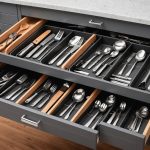Installing a water softener in your UK kitchen can significantly enhance water quality. Hard water can lead to scale buildup, affecting appliances and leading to higher energy bills. Evaluate factors like water hardness levels, the system’s capacity, and space requirements to ensure an effective setup. Understanding the implications of water softness not only improves daily life but also extends the lifespan of your kitchen appliances. Explore these critical steps to make an informed decision about your water softening needs.
Understanding Water Hardness Levels
Exploring the nuances of water hardness and its implications.
Also to see : Discover the Cutting-Edge Innovations Transforming Kitchen Composting Technology
Importance of Water Testing
Testing water hardness in the UK is crucial before installing any water treatment system. This ensures the chosen solution effectively addresses the specific hardness level of your water supply. Hard water can lead to mineral buildup in appliances, reducing efficiency and lifespan.
Water Hardness Scale
Water hardness is measured on a scale ranging from soft to hard. Understanding this scale helps in determining the need for a water softener. Here's a quick reference:
Also to read : Creative Solutions for Discreetly Concealing Your Kitchen Appliances
- Soft: 0-60 mg/L
- Moderately Hard: 61-120 mg/L
- Hard: 121-180 mg/L
- Very Hard: Over 180 mg/L
Effects on Appliances and Plumbing
Hard water can significantly impact household appliances and plumbing systems. The minerals in hard water, primarily calcium and magnesium, accumulate over time, leading to clogs and reduced efficiency. This can increase energy consumption and maintenance costs. A water softener can mitigate these issues by removing excess minerals, thus prolonging the life of your appliances and ensuring smooth plumbing operations.
Understanding water hardness levels empowers homeowners to make informed decisions about water treatment options, enhancing appliance efficiency and reducing long-term expenses.
Types of Water Softeners Available
Delving into the various options for effective water softening.
Ion Exchange Water Softeners
Ion exchange water softeners are the most common type, using resin beads to replace calcium and magnesium ions with sodium ions. This process effectively reduces water hardness, making it ideal for households experiencing high mineral content. The efficiency and reliability of these systems make them a popular choice for homeowners seeking a straightforward solution.
Advantages of Salt-Free Water Softeners
Salt-free water softeners offer an alternative approach by conditioning water without removing minerals. These systems prevent scale buildup by altering the chemical structure of the minerals, making them less likely to adhere to surfaces. Benefits include minimal maintenance and no need for salt refills, appealing to those seeking an eco-friendly option.
Electronic Descalers vs. Traditional Softeners
When comparing electronic descalers to traditional softeners, it's important to note their distinct functionalities. Electronic descalers use electromagnetic waves to alter mineral properties, reducing scale formation. They are easy to install and require little maintenance. In contrast, traditional ion exchange systems physically remove hardness minerals, providing a more comprehensive solution.
Comparison Table:
| Feature | Ion Exchange | Salt-Free | Electronic Descalers |
|---|---|---|---|
| Maintenance | Moderate | Low | Low |
| Mineral Removal | Yes | No | No |
| Environmental Impact | Moderate | Low | Low |
Selecting the right type of water softener depends on individual preferences, budget, and specific water hardness levels.
Space and Installation Requirements
Considerations for integrating water softeners into your kitchen space.
Evaluating Kitchen Layout
When planning to install a water softener, it's essential to assess the installation space available in your kitchen. The kitchen layout should accommodate the softener without obstructing daily activities. Typically, a compact area under the sink or a nearby utility space is ideal. Ensure the chosen spot allows for easy access to the softener for routine maintenance and service.
Plumbing Considerations
Different types of water softeners come with varied plumbing requirements. Ion exchange systems, for instance, need connections to the main water line and a drain for backwashing. Salt-free systems and electronic descalers may have simpler requirements but still need careful consideration of existing plumbing. It's crucial to plan for these requirements to avoid complications during installation.
Accessibility for Maintenance
Regular maintenance is key to the efficiency of your water softener. Choose an installation space that provides easy accessibility. This will facilitate tasks like adding salt to ion exchange systems or checking the functionality of electronic descalers.
Checklist for Installation:
- Adequate space under the sink or utility area
- Compatibility with existing plumbing
- Easy access for service and maintenance
By thoroughly evaluating these factors, you can ensure a seamless integration of your water softener into your kitchen.
Maintenance and Upkeep of Water Softeners
Ensuring longevity and efficiency through proper care.
Routine Maintenance Tasks
Regular water softener maintenance is crucial for optimal performance. Key tasks include inspecting the resin tank, ensuring it functions efficiently, and cleaning the brine tank to prevent salt bridges. A simple cleaning routine can significantly enhance the system's lifespan.
Importance of Salt Replenishment
Checking and replenishing salt levels is essential for ion exchange systems. The absence of adequate salt can lead to inefficient softening, allowing hard water minerals to pass through. It's advisable to keep the brine tank at least half-full, using high-quality salt pellets to maintain system efficiency.
Signs That Servicing is Needed
Recognizing when a water softener needs servicing can prevent costly repairs. Look for signs like reduced water pressure, hard water spots, or unusual noises from the unit. These indicate potential issues that require professional inspection.
Maintenance Checklist:
- Inspect and clean resin and brine tanks
- Regularly check and replenish salt levels
- Monitor for reduced water pressure and unusual noises
By adhering to these maintenance practices, homeowners can ensure their water softener operates effectively, providing soft water consistently and prolonging the life of household appliances.
Costs Associated with Water Softeners
Examining the financial aspects of water softeners.
Initial Purchase and Installation Costs
Water softener costs can vary significantly based on the type and model chosen. Initial purchase costs typically range from £300 to £1,500. Factors influencing installation expenses include labor and materials, which can add another £200 to £500 to the total cost. It's crucial to consider these upfront expenses when budgeting for a water softener system.
Long-Term Savings and Maintenance
Investing in a water softener can lead to substantial long-term savings. By reducing scale buildup, these systems enhance appliance efficiency, potentially lowering energy bills and repair costs. However, budgeting for ongoing maintenance and salt purchases is essential. Regular salt replenishment can cost between £50 and £100 annually, depending on usage and water hardness levels.
Factors Influencing Costs:
- Type and model of water softener
- Complexity of installation
- Frequency of maintenance tasks
Budgeting for Future Costs
When planning for a water softener, consider both installation expenses and future maintenance needs. Be mindful of potential repairs and the cost of high-quality salt for ion exchange systems. By understanding these financial aspects, homeowners can make informed decisions, ensuring the benefits of soft water without unexpected costs.
UK-Specific Regulations and Standards
Ensuring compliance with UK water regulations and installation standards.
Overview of UK Regulations
In the UK, water softener installations must adhere to specific regulations to ensure safety and functionality. The Water Supply (Water Fittings) Regulations 1999 outline requirements for preventing water contamination and ensuring efficient operation. Compliance with these regulations is crucial for maintaining water quality and safety in residential settings.
Importance of Compliance
Meeting local plumbing codes is essential when installing a water softener. Non-compliance can lead to legal issues and potential hazards. It's vital to work with certified professionals who understand these codes. Ensuring compliance not only protects your home but also guarantees the water softener operates efficiently.
Ensuring Your Installation Meets UK Standards
To ensure your installation aligns with UK standards, consider the following:
- Hire a certified installer familiar with UK regulations.
- Check for WRAS approval on all components.
- Conduct regular inspections to maintain compliance.
Checklist for Compliance:
- Certified installer
- WRAS-approved components
- Regular inspections
Adhering to these guidelines helps ensure your water softener system is both effective and legally compliant, providing peace of mind and optimal performance. Understanding and following UK-specific regulations is key to a successful installation and long-term satisfaction with your water softener system.
Product Reviews and Comparisons
Exploring the top water softener options available in the UK market.
Overview of Popular Brands
In the UK, several water softener brands stand out for their reliability and performance. Among these, Harvey and Kinetico are frequently highlighted for their advanced technology and durability. Water2Buy also garners attention for its budget-friendly models without compromising on quality.
Comparative Analysis
When comparing water softener reviews, consider features such as capacity, regeneration cycles, and ease of installation. Harvey models are praised for their twin-cylinder systems, ensuring continuous soft water. Kinetico offers non-electric models, appealing to those seeking energy efficiency. Water2Buy models are noted for their simple installation process, making them accessible for DIY enthusiasts.
Feature Comparison Table:
| Brand | Capacity | Regeneration | Energy Use |
|---|---|---|---|
| Harvey | High | Automatic | Low |
| Kinetico | Medium | Non-electric | None |
| Water2Buy | Variable | Manual | Moderate |
User Testimonials and Expert Opinions
User testimonials often highlight the long-term benefits of these water softener systems. Experts commend Harvey for its robust build and Kinetico for its innovative design. Water2Buy is favored by users for its affordability and effectiveness. These insights help potential buyers make informed decisions, ensuring the best fit for their needs.
Environmental Considerations
Exploring the eco-friendly aspects of water softeners and their impact.
Impact of Water Softeners on the Environment
Water softeners have environmental implications, particularly concerning water usage and discharge. Traditional systems can increase water waste due to their regeneration cycles. This process often involves flushing out minerals, leading to higher water consumption. However, understanding these impacts is crucial for choosing more sustainable options.
Overview of Eco-Friendly Alternatives and Their Benefits
Eco-friendly water softeners offer solutions that minimize environmental impact. These systems, such as salt-free models, condition water without excessive water use or chemical discharge. By altering mineral structure instead of removing them, they significantly reduce water waste. Their sustainability is further enhanced by the absence of salt, lowering the environmental footprint.
Benefits of Eco-Friendly Softeners:
- Reduced water consumption
- No chemical discharge
- Lower environmental impact
Considerations for Reducing Water Waste During Usage
To enhance sustainability, users can adopt practices that minimize water waste. Regular maintenance ensures systems operate efficiently, preventing unnecessary water usage. Opting for models with efficient regeneration cycles further supports this goal. Awareness and proactive measures can significantly contribute to the eco-friendliness of water softening solutions.
Key Considerations:
- Choose efficient systems
- Maintain regularly
- Opt for eco-friendly models
By integrating these practices, homeowners can enjoy the benefits of soft water while minimizing their environmental impact.
Final Considerations Before Installation
Ensuring a seamless integration of your water softener system.
Comprehensive Checklist of Factors
Before purchasing a water softener, it's crucial to review a comprehensive checklist to avoid common mistakes. Consider factors such as the space available for installation, the type of water softener that suits your needs, and the budget for both purchase and installation.
Checklist:
- Evaluate available space
- Choose the right type of softener
- Budget for purchase and installation
- Ensure compliance with local regulations
Common Mistakes to Avoid
Avoiding common installation mistakes can save time and resources. Ensure that the installation space is accessible for maintenance and that all plumbing connections are compatible with your chosen system. Overlooking these aspects can lead to inefficient operation and increased costs.
Tips for a Successful Installation Process
For a successful installation, follow these tips: hire a certified professional familiar with local regulations, and ensure all components are WRAS-approved. Regularly inspect the system post-installation to maintain compliance and efficiency.
Installation Tips:
- Hire certified professionals
- Use WRAS-approved components
- Conduct regular inspections
By adhering to this checklist and these tips, homeowners can ensure a smooth installation process, maximizing the benefits of their new water softener system while minimizing potential issues.













